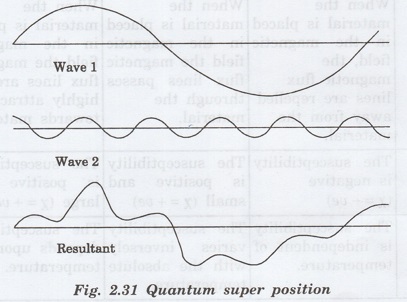Physics for Electronics Engineering: Unit II: Electrical and Magnetic Properties of Materials
Quantum Interference Effect
Quantum Superposition, Applications
It is a fundamental principle of quantum mechanics. It states that much like waves in classical physics, any two (or more) quantum states can be added together ("superposed") and the result will be another valid quantum state.
Quantum Interference Effect
Quantum superposition
It
is a fundamental principle of quantum mechanics. It states that much like waves
in classical physics, any two (or more) quantum states can be added together
("superposed") and the result will be another valid quantum state.
(Fig. 2.31)
Magnetic
fields can produce and control interference effects between the electrons in
solids. In order to observe interference

effects
between different electron waves, their phase has to be maintained.
The
phase coherence length Lφ is the distance travelled by an electron
without changing its phase. The phase of an electron wave is generally
destroyed when electrons interact inelastically with defects in the lattice.
In
general, ballistic electrons with a mean free path le much larger than sample dimensions L, (i.e. le >> L,) travel
through the lattice without scattering. Therefore they show interference
effects.
Applications of Quantum
Interference Effect
Quantum
interference effect is being applied in a growing number of applications, such
as the
i.
Superconducting Quantum Interference Device (SQUID).
ii.
quantum cryptography
iii. quantum computing and quantum interference transistor.
Physics for Electronics Engineering: Unit II: Electrical and Magnetic Properties of Materials : Tag: : Quantum Superposition, Applications - Quantum Interference Effect
Related Topics
Related Subjects
Physics for Electronics Engineering
PH3254 - Physics II - 2nd Semester - ECE Department - 2021 Regulation | 2nd Semester ECE Dept 2021 Regulation
